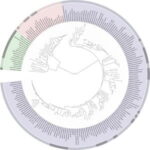From the Neolithic to the Urban Revolutions, the development of human civilization underwent many changes. These alterations were very influential to each other and to life today. Without these revolutions, we would still be hunter gatherers.
Before the Neolithic Revolution, humans were hunter gatherers. This time was called the Paleolithic Era or the Old Stone Age because most tools were made of stone. The hunter gatherers were nomadic peoples, having no set home. When they ran out of resources, they would move on to a place that they could find more provisions. The Neolithic Revolution, which started the Neolithic Period, began with the discovery of agriculture. The women of the nomadic hunter gatherer clans discovered that if you left the seeds of a plant beneath a rock or buried under ground, when you came back next season, they would have grown into the plant that the seed came from. The people of the nomadic societies realized that instead of letting the environment control the way they lived, that they could manage the environment to fit their way of life. This was what caused them to settle in one place. Along with agriculture came the domestication of animals. Instead of having to hunt for animals, they were trained to be herded into enclosed areas, and when meat was required, one could be easily killed. The technological awareness also increased during the Neolithic Revolution and tools were made such as the sickle.
After the Neolithic Revolution, the Neolithic Era lasted 5,000 years until the Urban Revolution occurred. This marked a period when trade, religion, and politics became more prominent parts of civilization. People had by now acquired possessions. When people wanted something that they did not own, they would find someone who wanted something that they did not still want so that they could trade it in for that item they needed. Also, some societies had different resources than others, so they used this bartering system in order to gain what they desired creating interdependence of civilizations. The religions of these peoples also became more complex through trade because when people from other civilization traded with yours, their ideas would spread thus creating a melting pot of ideas for religion. This is how the basic Mesopotamian religion became so similar to other religions. For example, the story of Ishtar and Tammuz from Mesopotamian religion is quite similar to the story of Osiris and Isis from Egyptian religion. The politics also became more prominent during the Urban Revolution. The rulers were kings which were all in some way connected with the gods, and the laws were for the most part very ethical, particularly in Egypt but not so much in Mesopotamia where they used Hammurabi’s code, “an eye for an eye, and a tooth for a tooth”. The age of metals also occurred during the Urban Revolution in 3,500 B.C.E. at this time, metal was discovered to be a good material to fashion weapons, tools, etc.
These two significant revolutions are still very prominent in our way of life today. Although we still hunt sometimes for pleasure, our ways of obtaining meat are mostly through domestication. The first animal to be domesticated was the dog, and today the dog is still “man’s best friend”. Humans still use farming as a means of obtaining fruits and vegetables. Although the methods of farming have adapted with the use of machinery, a tool that is still used today in farming is the sickle, which developed over time from being made of stone, to being made of metal, and now plastic. Today, religion is still prominent in our society, with the same roots as the Mesopotamian religions. In the epic of Gilgamesh, Ut tells Gilgamesh the story of how he had to build an ark because the gods were not pleased with human behavior and had chosen him to build an ark to send him, his family, and two of every animal on so they would not drown in the flood. This is remarkably similar to the story of Noah and the Ark found in the Christian Bible. These are just some of the important aspects that were borrowed from Mesopotamian religion.
Although we are still partially in the age of metals today, we have greatly developed since the Paleolithic Age. Our many accomplishments in civilization mark our advancements and our technological awareness as a race. From the Neolithic to the Urban Revolutions, civilization has changed and grown to be more complex, until it became what it is today.


